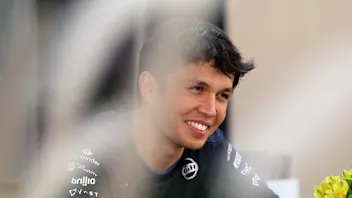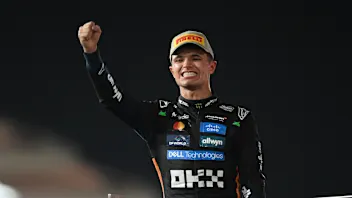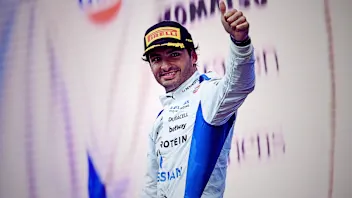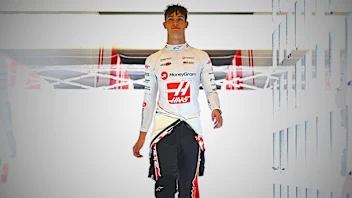Toro Rosso from A-Z
The 2015 season is Toro Rosso’s tenth in F1 racing. To mark the occasion, we present an alphabetised history of their first decade…
A is for… ASCANELLI
Renowned for having engineered Nelson Piquet at Benetton and Ayrton Senna at McLaren, Giorgio Ascanelli was Toro Rosso’s technical director from 2007 to 2012. As well as overseeing Sebastian Vettel’s fairy-tale win at Monza (see MONZA below), the Italian played a key role in Toro Rosso’s transition to fully-fledged constructor.
B is for… BUEMI and BOURDAIS
Toro Rosso’s other two ‘Sebs’, Sebastien Buemi and Sebastien Bourdais, racked up 55 and 27 starts respectively for the Italian team, though both would ultimately lose their drives. Bourdais subsequently returned to Indycar racing in the US, while Buemi, who still acts as Red Bull’s reserve driver, went on to achieve world championship glory in sportscars with Toyota.
C is for… CARS
For the first four years of their existence the DNA of Toro Rosso’s cars was nigh on identical to that of parent squad Red Bull’s. However, changes to the rules meant that from 2010 onwards the Italian team could no longer take advantage of Adrian Newey’s designs and instead had to become a bona fide constructor in their own right. The STR5 was the first car designed and produced entirely in house by Toro Rosso.
D is for… DIETRICH MATESCHITZ
Red Bull’s publicity shy Austrian owner who, having already established Red Bull Racing, decided in late 2005 to buy Minardi from Australian businessman Paul Stoddart in order to set up a feeder team for his main squad.
E is for… ENGINES
Formula One racing switched to a 2.4-litre V8 engine Formula in 2006, though controversial equivalency rules allowed Toro Rosso to continue to run a 3.0-litre V10 Cosworth during their inaugural season, albeit with significant rev and air intake restrictions. The following season the team switched to Ferrari power, and wouldn’t part ways with the Italian manufacturer until 2014 when they adopted the same Renault power units used by parent team Red Bull Racing.
F is for… FAENZA
The small town in Northern Italy in which Toro Rosso’s factory is situated. Minardi had previously operated out of the same headquarters.
G is for… GERHARD BERGER
Ahead of Toro Rosso’s debut season, ten-time Grand Prix winner Gerhard Berger acquired a 50 percent stake in the team from Red Bull boss and long-time friend Dietrich Mateschitz. The popular Austrian, who was a regular fixture in the paddock throughout his co-ownership, would eventually sell his shares back to Red Bull following the 2008 season.
H is for… HELMUT MARKO
A Grand Prix driver himself in the early Seventies, today Marko is Red Bull’s talent-spotter-in-chief, overseeing the company’s prodigious young driver programme. Firm and forthright, the Austrian has never been afraid to promote fresh talent, a tactic that ensures Toro Rosso’s drivers are always on their toes…
I is for… INDIANAPOLIS
It was at the circuit nicknamed ‘The Brickyard’ that Vitantonio Liuzzi scored Toro Rosso’s first F1 point in 2006 with an eighth-place finish. It would prove to be the team’s only point in a difficult debut season.
J is for… JAIME ALGUERSUARI
Until recently the youngest driver to have started a Grand Prix, Jaime Alguersuari was promoted to Toro Rosso’s line-up as a replacement for Sebastien Bourdais midway through the 2009 season, despite having virtually no F1 test experience. The 19-year-old Spaniard fared well, however, silencing the doubters who had suggested his inexperience could be a potential hazard to other drivers. Alguersuari went on to score 31 points for the team over two and a half seasons before being released at the end of 2011.
K is for… KVYAT
Daniil Kvyat saw off competition from other talented Red Bull juniors to gain his seat at Toro Rosso in 2014, but once there the Russian proved himself fully deserving of his opportunity. In his first ever race Kvyat finished ninth, becoming the youngest points scorer in the history of the sport, and by the season’s end he’d done enough to earn a call up to Red Bull Racing as Sebastian Vettel’s replacement.
L is for… LOEB
According to the man himself, multiple world rally champion Sebastien Loeb came ‘very close’ to driving for Toro Rosso at the 2009 season finale in Abu Dhabi. However, despite impressing in tests with Red Bull Racing, the Frenchman’s hopes were scuppered when he was unable to obtain a Super Licence.
M is for… MONZA
There can be no mistaking the high point of Toro Rosso’s ten-year F1 tenure - Sebastian Vettel’s improbable victory at the Faenza squad’s home race at Monza in 2008. Having shocked the paddock by giving the team their first pole in wet conditions on the Saturday, the 21-year-old German defied expectations to triumph in equally treacherous conditions on race day, becoming the youngest winner in F1 history to boot. In 14 previous years of racing, dating back to their inception as Minardi in 1985, the Italian team had never achieved so much as podium finish - now they’d beaten their bigger budget parent squad to the top step of the rostrum. A fairy tale if ever there was one.
N is for… NIGHT RACE
Toro Rosso have scored top six finishes in Italy, China, Monaco, Belgium, Valencia, Japan, Brazil and Canada, but Singapore is the only circuit at which they have scored top six finishes on more than one occasion. Sebastian Vettel finished fifth in the night race in 2008, whilst Jean-Eric Vergne came home a fine sixth in the 2014 event.
O is for… OUTSCORING
Vettel’s Monza victory helped Toro Rosso score 39 points in 2008, which, rather embarrassingly, was ten more than parent squad Red Bull Racing could manage with essentially the same car. The Italian team finished sixth in that year’s constructors’ standings - their best ever finish - but in the six seasons since then they’ve not got close to outscoring RBR.
P is for… PRESSURE
Such is the level of talent that continuously drops off Red Bull’s production line - and Helmut Marko’s propensity for promoting that same talent at a moment’s notice - that those driving for Toro Rosso are well aware that they have to deliver or face the chop. Of the nine drivers to have raced for the Italian team before this season, just three remain in F1 racing - Sebastian Vettel, Daniil Kvyat and Daniel Ricciardo, all of whom were promoted to Red Bull’s Milton Keynes-based squad. The others - Vitantonio Liuzzi, Scott Speed, Sebastien Bourdais, Sebastien Buemi, Jaime Alguersuari and Jean-Eric Vergne - no longer hold full-time F1 seats after being released by the team…
Q is for… QUARREL
The biggest bust-up in Toro Rosso’s history came at the rain-soaked European Grand Prix at the Nurburgring in 2007 when Scott Speed (see USA below) and team principal Franz Tost became embroiled in a heated argument following the American’s early race retirement. According to Tost, Speed had been very critical of the team after his lap one pit stop for wet tyres was delayed - an attitude that riled the Austrian, particularly as Speed had subsequently spun out of the race on the third lap. Perhaps unsurprisingly, Speed was replaced by Sebastian Vettel shortly afterwards.
R is for… RICCIARDO Daniel Ricciardo spent two seasons with Toro Rosso, during which time he developed a healthy rivalry with evenly-matched team mate Jean-Eric Vergne. The battle took on another dimension in 2013 when Mark Webber’s impending retirement from F1 racing left a seat open at Red Bull, but eventually Ricciardo’s superior consistency earned him a promotion to the parent squad. He justified his move almost immediately in 2014, outperforming quadruple champion team mate Sebastian Vettel and scoring three wins.
S is for… SQUADRA
In a nod to its Italian heritage the team was initially christened ‘Squadra Toro Rosso’ (Italian for ‘Team Red Bull’), but this was later changed to Scuderia Toro Rosso on the basis of squadra being a term more commonly associated with football teams.
T is for… TOST
Appointed ahead of Toro Rosso’s debut season in 2006, Franz Tost has been team principal ever since. Prior to joining the team the Austrian had been operations manager with BMW’s F1 programme.
U is for… USA
Appropriately named Californian racer Scott Speed formed one half of Toro Rosso’s original driver line-up in 2006, becoming the first American since Michael Andretti in 1993 to make it into Formula One racing. However, Speed’s association with the team would last just a season and half - having scored a best result of ninth over 28 races, the American was dropped in favour of rising star Sebastian Vettel (see QUARREL above).
V is for… Vettel
Having starred in a one-off drive for BMW-Sauber in the USA, Vettel was drafted in to replace Scott Speed midway through the 2007 campaign. The German, who Red Bull had groomed for greatness from an early age, was an instant hit with the Italian squad (quite literally, see WEBBER below), scoring a fine fourth place in China in what was just his sixth race for the team. The following year he recorded seven top-six finishes, including the team’s first and as-yet only win; results that earned him promotion to Red Bull Racing for 2009. The rest, as they say, is history…
W is for… WEBBER
At the 2007 Japanese Grand Prix, held in torrential conditions at Fuji, Mark Webber was on course to challenge for his and Red Bull’s first ever win when, under safety car conditions late in the race, he was accidentally punted into retirement by rookie Toro Rosso stablemate (and future Red Bull team mate) Sebastian Vettel. For the young German, who had been running an impressive third, there were rueful tears; for Webber only fury at an opportunity missed…
X is for… (E)XPLODING TYRES!
We’ve cheated a little here, but for good reason: who could forget Sebastien Buemi’s STR5 spectacularly shedding its front tyres at the end of China’s long back straight during FP1 in 2010? Thankfully no one was injured in the bizarre accident, which was later discovered to have been caused by a problem with the right-hand suspension upright.
Y is for… YOUTH
As a team whose primary function has always been to help Red Bull-backed talent take their first steps in Grand Prix racing, it’s perhaps unsurprising that the average age of a driver making his debut for Toro Rosso is just 21. Max Verstappen, who this season forms one half of F1 racing’s youngest ever driver line-up with Carlos Sainz, became the youngest man in history to start a Grand Prix in Australia, aged just 17 years, 5 months and 13 days.
Z is for… ZERO
Toro Rosso have achieved many things in ten years - one pole position, one race victory, 56 led laps and more than 200 points scored. But one thing missing from their list of accolades is a fastest lap. Will 2015 finally be the year?
Next Up
Related Articles
 Albon names moment he's most proud of from 2025
Albon names moment he's most proud of from 2025.webp) End Of Year Reports 2025Alpine’s best and worst moments from 2025
End Of Year Reports 2025Alpine’s best and worst moments from 2025 WATCH: F1 Animated returns for a look back at 2025
WATCH: F1 Animated returns for a look back at 2025 The elite group Norris joins as McLaren World Champion
The elite group Norris joins as McLaren World Champion ExclusiveWhy Sainz feels ‘vindicated’ after his first Williams year
ExclusiveWhy Sainz feels ‘vindicated’ after his first Williams year ExclusiveHow Bearman went from super-sub to star rookie in 2025
ExclusiveHow Bearman went from super-sub to star rookie in 2025